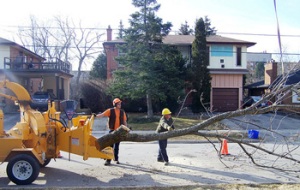“Whistle while you work! Tootle-oo-too-to-too-toot!”
“Argh! Stop the chipper again! Another nest.“
That was the fifth robin’s nest we pulled out of the chipper’s hydraulic pump recently. It is not good for the robins or the chipper to have nests going through it. The poor birds lose their homes, and potentially eggs, while their nests serve as a fire hazard for the machinery. We don’t want either to happen, but every time we have to rescue a bird’s nest, it slows down our productivity.
What is a chipper and what do we do with it though, you ask ? Excellent question! Let me explain a little bit about one of the pieces of equipment that we regularly use at CLC Tree Services today.
Here is an image from our photo gallery of our tree chipper hard at work. The business that CLC Tree Services is in, is tree maintenance. We plant and fertilize trees, but the bigger part of our job is to prune and cut them down. As you can see by the picture above, some of the tree limbs can get rather large. We do not bundle up all of the branches that we cut down to leave at the side of the road for the city to come and collect on yard waste days. Depending upon the size of the tree we are working on, you wouldn’t be able to see the house some days from the branches we remove! We also don’t take those limbs back to the shop with us. We would run out of space pretty darn quickly if we did that, let me tell you.
So what do we do with all of the branches that we cut down, you wonder? That is where our handy chipper comes in. As we cut off twigs, branches and larger pieces from trees, we need to dispose of them. A chipper helps us to do just that.
Generally, we have one person removing limbs, be it by climbing the tree or using our cherry picker to access and cut appropriate branches. The rest of the crew carefully collects all of the fallen branches. They then carry or drag the discarded limbs over to the chipper and load them in the hopper. The hopper is the collared opening that offers a measure of safety for the crew from the blades within the chipper. Most wood chippers have rollers that help to feed the branches into the actual machine. It is vitally important to always be mindful of the blades, and best to stand to the side of the chipper when loading branches in, to ensure that no clothing is snagged. Chippers are very powerful machines and capable of killing a man, if they are dragged into the blades. Those sharp blades are meant to shred branches, not people, so safety is always foremost on our minds.
As branches are fed into the hopper, they are grasped by the blades and pulled through the machine. The blades grind up the branches into one to two inch chunks (or sawdust if preferred) and shoots them out an exit chute at the opposite end of the chipper. Like most tree services companies, we have our chipper attached to a truck for the resulting debris to be shot into. That debris can be used as mulch to be added to your gardens, or the base of your trees to improve water retention, but generally we load up our truck and leave your property as clean as we can. Better in fact, as after we leave your tree is in better shape than when we arrived.
So while tree chippers are powerful machines, their value is in the little things that they do. We like to think of them as an aide in our part in reducing the waste in our industry. They take big limbs and branches, and process them into smaller, more manageable pieces. They are essential to our job, so we take the best care of them that we can. That means that we keep our hands and arms out of it, plus we remove any other material that might be hazardous to it. So little Robin Redbreast is saved again this week from the jaws of our chipper, and we have the joy to hear their song after the loud beat of the chipper is turned off for the day.
And we all keep rolling along.



You must be logged in to post a comment.